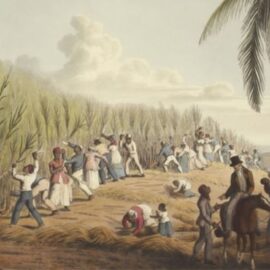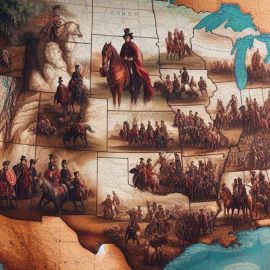

This article is an excerpt from the Shortform book guide to "Biased" by Jennifer L. Eberhardt. Shortform has the world's best summaries and analyses of books you should be reading.
Like this article? Sign up for a free trial here .
How did generations past use science to “prove” that some races were better than others? What were the three phases of scientific bias? What lasting impacts did racial pseudoscience have on society?
In her book Biased, Dr. Jennifer Eberhardt discusses the three phases of historical scientific bias: human hierarchies, polygenesis, and evolutionary IQ. In the past, biased scientists would use pseudoscience and lies to justify inhumane acts such as slavery. Unfortunately, although disproved, many of the ideas are still deeply ingrained in society.
Continue reading to learn about the dark history of scientific bias.
Bias in Science and Pseudoscience
Unfortunately, racial bias isn’t a new trend. Racial bias is a centuries-old phenomenon that began as a way to justify slave trading. Over time, that bias solidified as leading scientists invented baseless theories that black people were not fully human and therefore fundamentally inferior to white people. This process is called scientific racism, and it’s one of the biggest reasons that racial bias has persisted for so long.
The History of Scientific Bias
Scientific racism is the false theory that different racial groups have fundamentally different physical and mental traits. According to Eberhardt, supporters of this theory believe those traits are universal, immutable, and objective, meaning that white supremacy and black inferiority are facts of nature rather than social constructs. Throughout history, scientists and academics have used scientific racism to justify their own racial bias as well as the entrenched racial inequality in their societies. (Shortform note: Some scholars, like Ibram X. Kendi, author of How to Be an Antiracist, use the term “biological racism” to describe these same ideas.)
As we’ll see below, scientific racism began with scientists inventing “natural” racial hierarchies, then evolved over time into a debate on the biblical origins of race, and finally adapted to fit the new understanding of human evolution and natural selection.
Phase 1: Human Hierarchies
In the 19th century, several prominent scientists published supposed hierarchies of humanity based on differences in physical and mental traits. Respected doctors and scientists wrote what they considered to be purely objective scientific texts asserting that black people were an entirely different species and therefore naturally inferior to white people.
Eberhardt argues that the original goal of these texts was to defend Europe and America’s economic interests in the slave trade against moral or religious objections. Scientists of the time provided the perfect cover: Black people were fundamentally, biologically inferior to white people and servile by nature, so slavery was simply part of the natural order of things. That “scientific” justification absolved white slaveholders of any guilt over kidnapping and enslaving fellow human beings. Over time, justifying bias and prejudice against black people became a fundamental part of mainstream science.
(Shortform note: While there’s no excuse for prejudice, author Jordan Peterson argues in 12 Rules for Life that the urge to establish social hierarchies is an evolutionary instinct that humans share with other animals, such as lobsters.)
Many of the scientists providing these false justifications for slavery focused on the size and shape of human skulls to prove their points. The most infamous of these scientists was American physician Samuel George Morton, who believed that the size of a person’s skull was a direct indicator of their intellectual ability. He collected thousands of human skulls from around the world, categorized them by race, and measured their capacity by filling them with lead pellets. Morton concluded from those studies that white Europeans were the most intelligent (and therefore most evolved) humans, and that Africans and Native Americans were separate, inferior species.
(Shortform note: Many of the skulls Morton collected belonged to people who had been enslaved. After his death, Morton’s collection ended up at the University of Pennsylvania Museum of Archaeology and Anthropology. In 2020, in response to the national wave of antiracist activism, the museum removed the skulls from public display and formed a committee focused on repatriating the skulls of enslaved people.)
Morton’s ideas about skull capacity and human intelligence became the foundation of the field of physical anthropology, which uses physical anatomy to study human behavior and culture. As we’ll see, physical anthropology would go on to become a hotbed of scientific bias.
Phase 2: Polygenesis
In the highly religious culture of 19th century America, the idea that black people and white people were entirely different species presented a challenge: Christianity only recognizes one creation story, not two, so all humans should theoretically be the same species. Eberhardt tells us that religious writers were divided on this question: Some supported the theory of monogenesis (a single creation story), others supported polygenesis (multiple creation stories). Supporters of monogenesis believed that all of humankind originated from Adam and Eve in the Garden of Eden; supporters of polygenesis believed that there were separate creation events for each race, but only the creation of white people was important enough to be included in the Bible.
In 1854, writers Josiah Nott and George Gliddon merged polygenesis and the pseudoscience of human hierarchy into a single idea: White people originated from Adam and Eve, but people of all other races were created separately, more akin to animals than to the first humans. This led them to conclude that slavery was the natural order of the universe.
| Justifying Slavery With the “Curse of Ham” In How to Be an Antiracist, Ibram X. Kendi describes another common religious justification for racism during this period: The “Curse of Ham,” based on the biblical story of Noah (of ark-building fame) cursing the descendants of his son, Ham, to serve as slaves to one of his other sons, Shem. Although there’s no mention in the story of Ham having dark skin, proponents of slavery claimed that all Africans were descended from Ham’s line and therefore destined to be enslaved. |
Justifying Polygenesis With Science
Like other scientific racists of the time, Nott and Gliddon focused on comparing human skulls to make their point. At the time, most scientists believed that brain size was linked to intelligence—to them, a larger skull meant a larger brain, which meant higher intelligence. Therefore, to prove white people’s superiority, these scientists set out to prove that white people had larger average skull sizes than black people. However, in reality, Eberhardt tells us that there is no difference in average skull size between people of different races.
(Shortform note: Modern scientists have found a correlation between skull measurements and geographic origin. However, that doesn’t mean that science supports using skull measurements to identify different races, because race and geographic origin are not the same thing. Geographic origin is the continent where your ancestors came from; race is the social category you fall into based on traits like skin color or language.)
Without actual physical evidence, scientists had to rely on grossly exaggerated sketches of human skulls to show the biological differences they claimed to have discovered. These sketches became the template for the racist caricatures we still see today.
For example, the image below (from Nott and Gliddon’s 1854 book Types of Mankind) claims to show the skulls of a white person, a black person, and a chimpanzee. Eberhardt believes that the authors’ goal was to make it abundantly clear to even non-scientist readers that black people were biologically closer to apes than human beings. In the illustration, the black person’s skull is contorted beyond recognition—it’s arguably even less human-shaped than the chimpanzee skull—and the black face beside it is an early example of racist caricature. On the other hand, the drawing of the white person’s head is exaggerated to the other extreme: It’s based on a statue of the Greek god Apollo, which many consider to be the pinnacle of physical attractiveness.
[image] biased_3skulls.png
| Types of Mankind and Harvard’s Complicated History of Racial Bias The original citation for Types of Mankind includes “additional contributions” from other authors, including Louis Agassiz, a Swiss-American scientist and Harvard lecturer who was well-known at the time as the founder of Harvard’s Museum of Comparative Zoology. As a Harvard biologist, Agassiz lent a sense of academic credibility to the book, as the primary authors were not biologists—Nott was a surgeon and Gliddon was an Egyptologist. By attaching his name and his academic clout to the book, Agassiz helped make Types of Mankind an instant best-seller. While at Harvard, Agassiz also commissioned a series of daguerreotypes of enslaved men and women, shown without clothing, that became some of the earliest surviving images of enslaved people in America. In 2019, the university came under fire when Tamara Lanier—a direct descendant of two of the people featured in the daguerreotypes—sued the university for profiting off the images of her ancestors, who wouldn’t have been able to legally consent to having their picture taken. Although she lost the case, Lanier’s lawsuit exposed the lingering influence of Agassiz’s racism at Harvard, prompting internal changes. Until 2019, the website for the Museum of Comparative Zoology lauded their founder as a “renowned teacher of natural history”; now, the site features a large “Black Lives Matter” banner across the main page and an official statement denouncing Agassiz’s ideas. |
Around the time Nott and Gliddon were creating these racist sketches, French scientist Paul Broca discovered that brain function is localized, meaning certain physical areas of the brain are responsible for certain functions (like speech, emotions, sensory perception, and so on). Today, Broca is best known for discovering the brain region responsible for producing coherent speech—that region is still called “Broca’s area” in his honor—but few people know the racist motivations for his discoveries.
Broca was a firm believer in polygenism and the basic tenets of physical anthropology. However, according to Eberhardt, Broca’s understanding of brain localization added another layer of complexity to these concepts by examining the shape of the skull. He understood that basic functions like sensory processing happened closer to the base of the brain (the occipital lobe) while more complex functions like logical reasoning happened in the upper front of the brain (the frontal lobe).
This knowledge shaped Broca’s theory that differences in skull shape predicted differences in intelligence: Someone whose skull was larger in front must have a larger frontal lobe (and be more intelligent) than someone whose skull was larger in the back (and therefore had less capacity for rational thought). Like other European scientists at the time, Broca believed that all black people had more forward-jutting skulls than white people, with a larger capacity at the base than the front; consequently, they must also have overdeveloped occipital lobes and underdeveloped frontal lobes. Broca offered up this theory as a way to explain what he saw as the natural, inborn intellectual and social inferiority of black people as a whole.
(Shortform note: Broca’s discoveries were based on the pseudoscience of phrenology, or the idea that localized brain functions created unique shapes and features in a person’s skull. Phrenology proponents believed that tiny bumps and craters in different parts of someone’s skull were clues to their intelligence, personality, and moral character. Today, scientists know that brain functions are localized, but not in the highly pinpointed way that phrenologists believed, and those brain areas don’t impact the shape of the skull based on how well they function.)
Phase 3: Evolution and IQ
Shortly after Nott and Gliddon published Types of Mankind and Broca discovered his eponymous brain region, Charles Darwin rocked the scientific community with his theory of evolutionary biology in On the Origin of Species. Darwin argued that all humans were part of a single species that originated in Africa; but as we spread out over the world, different groups of people evolved differently to suit their unique physical environment.
According to Eberhardt, the new theory of evolution effectively ended debates on polygenism, but it could not wipe out scientific bias. Instead, scientists found new theories to justify racial bias: If humans are capable of physical evolution, then white people must be the most evolved humans. In that worldview, any non-white person represented a more primitive stage of evolution.
By the early 20th century, most scientists accepted Darwin’s ideas, and false theories about skull size and intelligence began to fade. In their place came a new tool for scientifically “proving” white intellectual superiority: the intelligence quotient (IQ) test. The IQ test is not a neutral, objective measure of intelligence. It was specifically designed to quantify the overall intelligence of different racial groups, provide “objective” evidence of white superiority, and use that evidence to justify and reinforce racial bias in existing institutions.
| The Link Between IQ Tests, Scientific Racism, and Eugenics The modern IQ test was first developed by French psychologist Alfred Binet in 1905. During World War I, the U.S. Army administered the test to millions of recruits, which paved the way for the widespread use of IQ tests. At that time, scoring well on the test required extensive knowledge of upper-class American pop culture, which meant that recent immigrants and working-class people (many of whom were people of color) were at an automatic disadvantage—unsurprisingly, rich whites scored far higher on IQ tests than any other group. The growing eugenics movement in the United States used these score differences as proof of a fundamental difference in intelligence between racial groups. In the years following World War I, eugenicists were increasingly using IQ tests to identify candidates for forced sterilization and institutionalization. In 1927, the Supreme Court upheld states’ rights to sterilize “feebleminded” people (as identified by IQ tests) without their consent in the Buck v. Bell ruling; in the following 10 years, 28,000 Americans were forcibly sterilized. During the Nuremberg trials after World War II, Nazis specifically cited Buck v. Bell as inspiration for their own eugenics programs. |
The Lasting Impact of Scientific Bias
Unfortunately, scientific racism is not just a historical phenomenon. Old ideas about black inferiority are so deeply ingrained in Western culture that they persist to this day. In particular, the association between black people and apes is still alive and well, whether we’re consciously aware of it or not.
| Modern Confusion About “Biological Race” Most modern scientists have abandoned the idea of “biological race” (that is, the idea that racial groups are biologically and genetically distinct from one another), but these ideas are still prevalent in the general population. In fact, nearly 53% of Americans believe that “biology determines your racial identity.” However, biological anthropologist Alan Goodman argues that there’s often more genetic variation between any two people of the same race than between different racial groups. Goodman also tackles the common misunderstanding that sickle cell anemia is proof of biological race because it’s most common in people of African descent. While that is true, the reality is more complicated: The gene variant that causes sickle cell anemia is common in West Africa (as well as India, the Mediterranean, and the Middle East), but practically nonexistent in the rest of the African continent. That means that not all black people are susceptible to sickle cell anemia, and not everyone who carries the genes for the disease falls under the racial category of “black.” In other words, race isn’t the determining factor—geography is. |

———End of Preview———
Like what you just read? Read the rest of the world's best book summary and analysis of Jennifer L. Eberhardt's "Biased" at Shortform .
Here's what you'll find in our full Biased summary :
- How implicit bias forms in the brain
- Whether or not bias training actually works
- Why there has been a sudden resurgence in white nationalism






